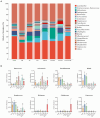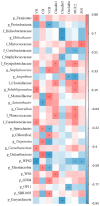Dietary supplementation with Chinese herb ultrafine powder improves intestinal morphology and physical barrier function by altering jejunal microbiota in laying hens
- PMID: 37260679
- PMCID: PMC10227515
- DOI: 10.3389/fmicb.2023.1185806
Dietary supplementation with Chinese herb ultrafine powder improves intestinal morphology and physical barrier function by altering jejunal microbiota in laying hens
Erratum in
-
Correction: Dietary supplementation with Chinese herb ultrafine powder improves intestinal morphology and physical barrier function by altering jejunal microbiota in laying hens.Front Microbiol. 2025 Jun 9;16:1628339. doi: 10.3389/fmicb.2025.1628339. eCollection 2025. Front Microbiol. 2025. PMID: 40552052 Free PMC article.
Abstract
Introduction: Chinese medicinal herbs play important roles in anti-inflammatory, antioxidant, and antibacterial activities. However, the effects of Chinese herb ultrafine powder (CHUP) on laying hens still need to be elucidated. Therefore, this study aimed to evaluate the effects of dietary CHUP supplementation on jejunal morphology, physical barrier function, and microbiota in laying hens.
Methods: A total of 576 Xinyang black-feather laying hens (300 days old) were randomly assigned into eight groups, with eight replicates per group and nine hens per replicate. The hens were fed a basal diet (control group) and a basal diet supplemented with 0.5% Leonuri herba (LH group), 0.25% Ligustri lucidi fructus (LF group), 0.25% Taraxaci herba (TH group), 0.5% LH + 0.25% LF (LH-LF group), 0.5% LH + 0.25% TH (LH-TH group), 0.25% LF + 0.25% TH (LF-TH group), and 0.5% LH + 0.25% LF + 0.25% TH (LH-LF-TH group), respectively, for 120 days.
Results: The results showed that dietary LH-LF and LH-LF-TH supplementation increased (p < 0.05) the jejunal villus height to crypt depth ratio of laying hens. Dietary LF-TH supplementation up-regulated jejunal claudin-5 expression, while LH supplementation up-regulated jejunal claudin-1 expression and increased the jejunal abundances of potentially beneficial bacteria related to short-chain fatty acids and bacteriocins production, such as Blautia, Carnobacterium, Clostridiales, and Erysipelotrichales (p < 0.05). In addition, dietary LH supplementation enriched (p < 0.05) the tetracycline biosynthesis, butirosin/neomycin biosynthesis, and D-arginine/D-ornithine metabolism, whereas steroid biosynthesis and limonene/pinene degradation were enriched (p < 0.05) in the LH-LF and LH-LF-TH groups. Moreover, Spearman's correlation analysis revealed the potential correlation between the abundance of the jejunal microbiota and jejunal morphology and the physical barrier function of laying hens.
Discussion: Collectively, these findings suggest that dietary CHUP supplementation could enhance the beneficial bacteria abundance, physical barrier function, and metabolic function associated with short-chain fatty acids and bacteriocins production. Moreover, combined supplementation of dietary CHUP showed better effects than the sole CHUP supplementation.
Keywords: Chinese herb; Xinyang black-feather hens; intestinal barrier function; microbiota; ultrafine powder.
Copyright © 2023 Gui, Azad, Lin, Meng, Hu, Cui, Lan, He and Kong.
Conflict of interest statement
The authors declare that the research was conducted in the absence of any commercial or financial relationships that could be construed as a potential conflict of interest.
Figures










Similar articles
-
Dietary compounded traditional Chinese medicine residue meal improves laying performance, egg quality, and gut barrier integrity in late-phase laying hens.Poult Sci. 2025 Sep;104(9):105425. doi: 10.1016/j.psj.2025.105425. Epub 2025 Jun 11. Poult Sci. 2025. PMID: 40570464 Free PMC article.
-
Dietary Fermented Blueberry Pomace Supplementation Improves Small Intestinal Barrier Function and Modulates Cecal Microbiota in Aged Laying Hens.Animals (Basel). 2024 Sep 26;14(19):2786. doi: 10.3390/ani14192786. Animals (Basel). 2024. PMID: 39409735 Free PMC article.
-
Responses of intestinal morphology, immunity, antioxidant status and cecal microbiota to the mixture of glycerol monolaurate and cinnamaldehyde in laying hens.Poult Sci. 2024 Jun;103(6):103645. doi: 10.1016/j.psj.2024.103645. Epub 2024 Mar 13. Poult Sci. 2024. PMID: 38547675 Free PMC article.
-
Aronia melanocarpa pomace enhances egg production and quality in late-laying hens via modulating gut microbiota and lipid metabolism.Br Poult Sci. 2025 Jul 28:1-15. doi: 10.1080/00071668.2025.2526157. Online ahead of print. Br Poult Sci. 2025. PMID: 40719240 Review.
-
Home treatment for mental health problems: a systematic review.Health Technol Assess. 2001;5(15):1-139. doi: 10.3310/hta5150. Health Technol Assess. 2001. PMID: 11532236
Cited by
-
Effects of Traditional Chinese Herbal Feed Additive on Production Performance, Egg Quality, Antioxidant Capacity, Immunity and Intestinal Health of Laying Hens.Animals (Basel). 2023 Aug 3;13(15):2510. doi: 10.3390/ani13152510. Animals (Basel). 2023. PMID: 37570319 Free PMC article.
-
Network pharmacology and molecular docking reveal the mechanism of Chinese herb ultrafine powder improving meat nutritional value in aged laying hens.Poult Sci. 2025 May;104(5):105047. doi: 10.1016/j.psj.2025.105047. Epub 2025 Mar 16. Poult Sci. 2025. PMID: 40138971 Free PMC article.
-
Effects of the Salvia miltiorrhiza, Ligustrum lucidum, and Taraxacum mongolicum ultra-fine powder formula on meat quality of aged layers by multi-omics.Poult Sci. 2025 Feb;104(2):104783. doi: 10.1016/j.psj.2025.104783. Epub 2025 Jan 5. Poult Sci. 2025. PMID: 39823836 Free PMC article.
References
-
- Ashour E. A., El-Kholy M. S., Alagawany M., Abd El-Hack M. E., Mohamed L. A., Taha A. E., et al. (2020). Effect of dietary supplementation with Moringa oleifera leaves and/or seeds powder on production, egg characteristics, hatchability and blood chemistry of laying Japanese quails. Sustainability 12:2463. doi: 10.3390/su12062463 - DOI
-
- Bedford M. R., Cowieson A. J. (2012). Exogenous enzymes and their effects on intestinal microbiology. Anim. Feed Sci. Technol. 173, 76–85. doi: 10.1016/j.anifeedsci.2011.12.018 - DOI
LinkOut - more resources
Full Text Sources

